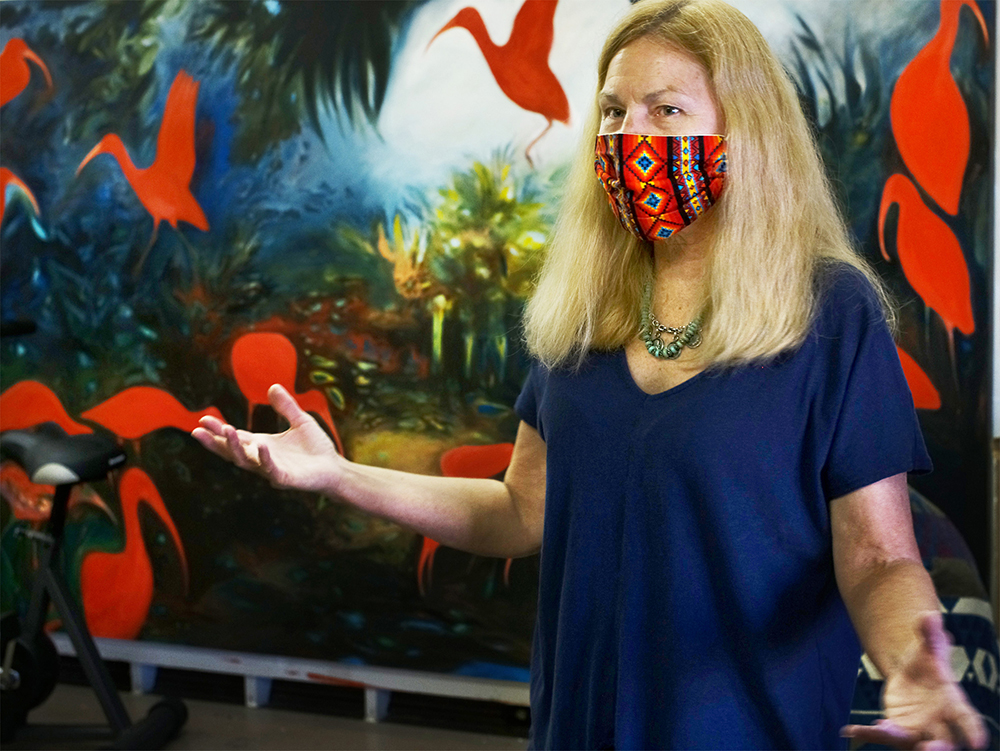
Rhea Edge explains why her abstract art, including this painting of the Scarlet Ibis, provides a larger, more contextualized understanding of crisis than her realistic works. Abstract art “represents a larger picture of our fragile interconnectedness and the delicate balance of life between all living things, and that includes people. Each location is representative of the deterioration of the global habitat.” (COMMUNITY WORD PHOTO)
Art is a powerful language that can communicate through a combination of facts, emotion, conviction, beauty and degradation. Artist Rhea Edge knows how to wield all these tools.
She uses her art to convey an environmental message and a moral message that breaks through words and facts. Her art speaks a truth that is often obscured by manipulative phrasing and partisan politics.
She shows us the vulnerabilities of endangered species and their impending extinction. It’s beautiful. It’s disconcerting. It leaves viewers with uncomfortable moral questions.
Edge, professor of art and chairwoman of the fine and performing arts department at Eureka College, has traveled extensively documenting animal extinctions around the world. She has paintings of the Scarlet Ibis in Trinidad, Sandhill Cranes in Nebraska, leatherback turtles on a Florida beach and tigers in India. Over decades, her message has been a clarion call for climate justice.
During repeat visits to locations around the world, she has witnesses the transformation of some regions from pristine environments to highly degraded ecosystems.
Edge is a skilled realistic painter and a powerful abstract painter.
People sometimes ask her why she doesn’t just paint realistically.
She said the abstract work “represents a larger picture of our fragile interconnectedness and delicate balance of life between all living things, and that includes people. Each location is representative of the deterioration of the global habitat.”
The need to protect and preserve animal life has been part of her passion since childhood. People told her that her early paintings were “not particularly beautiful to look at.” Those people included art teachers who tried to push her onto a different path.
But Edge said her goal is not pretty pictures but truth.
She can trace her fascination with history and evolution to her childhood visiting zoos in the Chicago area, the Field Museum, Museum of Science and Industry and the Art Institute. She didn’t have access to the natural world so she began collecting images, artifacts and models.
“Can art be a vehicle for social change?” she asks her students at Eureka College.
The answer is yes, art can be activism. Art is thinking outside the box, she tells students. It’s a message, not unlike the power of messaging that soldiers carry with them into battle. Art can be a force driving people to act and to fight for justice.
“Art can be a shared ethical value system,” Edge said. “Art can be a bridge to help others see what you see. Art can establish trust.”
She also teaches art therapy not as a way for students to help others, but as a way for them to use art to clarify their own core values and beliefs.
She said the COVID-19 pandemic offers an apt metaphor. Does someone in our own family have to die before we allow the news to reach into our human emotions and force us to recognize the needs of society as a whole above the notion of self.
“If you have lost your way due to outside pressures, allow art to remind you to trust your values,” she said.

1 comment for “Art and Justice | Rhea Edge: Her art calls for environmental justice”
Recent Comments
Rhea, so good to know that you are teaching and painting! Eureka College is lucky to have you. I haven’t done art for a long time but I am taking an art workshop in April in Mattoon, IL. Betty Potts, Greenup ,IL